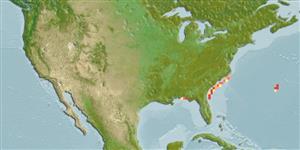Gastropoda |
Littorinimorpha |
Naticidae
Environment: milieu / climate zone / djupintervall / distribution range
Ekologi
Revassocierade; djupintervall 0 - 175 m (Ref. 83934). Subtropical; 27°C - 28°C (Ref. 87155); 35°N - 30°N, 96°E - 0°E (Ref. 83435)
Atlantic Ocean and the Mediterranean.
Length at first maturity / Size / Weight / Age
Könsmognad: Lm ? range ? - ? cm Max length : 4.0 cm NG hane/ej könsbestämd; (Ref. 83435)
This species is found intertidal and offshore, on coral reefs and cienaga facies, on rock and sand habitats (Ref. 83934).
Life cycle and mating behavior
Könsmognad | Reproduktion | Lek | Eggs | Fecundity | Larvae
Members of the order Neotaenioglossa are mostly gonochoric and broadcast spawners. Life cycle: Embryos develop into planktonic trocophore larvae and later into juvenile veligers before becoming fully grown adults.
Templado, J. and R. Villanueva 2010 Checklist of Phylum Mollusca. pp. 148-198 In Coll, M., et al., 2010. The biodiversity of the Mediterranean Sea: estimates, patterns, and threats. PLoS ONE 5(8):36pp. (Ref. 85339)
IUCN Red List Status
(Ref. 130435: Version 2025-1)
CITES status (Ref. 108899)
Not Evaluated
Not Evaluated
Threat to humans
Human uses
| FishSource |
Verktyg
Ytterligare information
Trophic EcologyFood items (preys)
Födosammansättning
Födointag
Predatorer
Population dynamicsTillväxt
Max. ages / sizes
Length-weight rel.
Length-length rel.
Length-frequencies
Mass conversion
Abundans
PhysiologySyreförbrukning
Human RelatedStamps, coins, misc.
Internet-källor
Estimates based on models
Preferred temperature
(Ref.
115969): 22.8 - 24.7, mean 24.1 (based on 32 cells).
Fishing Vulnerability
Low vulnerability (10 of 100).
Price category
Unknown.
